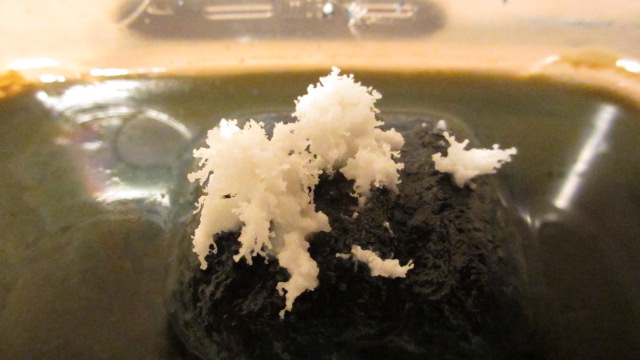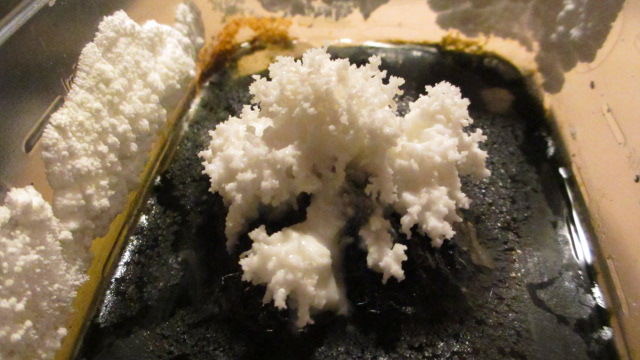I was intrigued by the different variables that could affect the salt crystal growth, some of which were already described on the site. I decided to explore the effects of varying the amount of liquid bluing and ammonia. The amount of bluing would be either 4, 8, or 12 tbsp and the amount of ammonia would be either 4 tbsp, 2 tbsp, or none and then 8 tbsp added to the solution on the third day. Testing each combination gave me 9 different samples, which I labelled samples A through I. These are listed below under "sample amounts".
Note: This experiment lasted about two weeks. During that time, I measured humidities between 41 and 52% and temperatures between 66 and 77 degrees Fahrenheit in my closet where the samples were set.
Ingredients and materials:
-4 tbsp tap water
-4 tbsp table salt
-liquid bluing (see sample amounts)
-ammonia (see sample amounts)
-charcoal pieces
-vaseline
-plastic containers
-tbsp measure
-gloves
-goggles
Sample Amounts:
Sample A
4 tbsp liquid bluing
4 tbsp ammonia
Sample B
8 tbsp liquid bluing
4 tbsp ammonia
Sample C
12 tbsp liquid bluing
4 tbsp ammonia
Sample D
4 tbsp liquid bluing
2 tbsp ammonia
Sample E
8 tbsp liquid bluing
2 tbsp ammonia
Sample F
12 tbsp liquid bluing
2 tbsp ammonia
Sample G
4 tbsp liquid bluing
no ammonia then 8tbsp on 3rd day
Sample H
8 tbsp liquid bluing
no ammonia then 8tbsp on 3rd day
Sample I
12 tbsp liquid bluing
no ammonia then 8tbsp on 3rd day
Documentation:
Recipes completed at 4:00pm on 2/9/16.
 |
| the setup |
After 2 hours: I sprinkled four pinches of salt on top of each of the charcoal pieces. (At this point, no visible crystals have started forming yet.) Sample A's solution has turned a dark, brownish red color, but all the other samples remain a dark blue.
After 4 hours (2 hours after additional salt was added): Crystal can be seen growing on top of all of the charcoal briquettes. Upon closer inspection, the brownish red solution of sample A is growing plenty of salt underneath the surface. Sample D's solution is turning a dark yellow, and sample B has patches of yellow as well. The liquid bluing appears to have settled to the bottom of each container. With the exception of samples G, H, and I, all the samples have at least some crystals forming on the edges of the briquettes and the bottom of the container.
After 48 hours: Most the samples look roughly the same as they did when I last checked. However, sample F has begun to clearly grow crystals upwards from the coal briquette.
After 72 hours (3 days):
In addition to sample F, samples A and D have also begun to acquire salt crystal growth. Sample A's growth has overtaken sample F, so far doing the best of the three.
After 96 hours (4 days):
Since it took a while for the solutions to evaporate, I waited until the 4th day (instead of the 3rd) to add more solution. Since none of the samples needed much additional liquid, I made a half recipe for each sample, except for samples F, H and I, for which I made quarter recipes.
Pictures were taken before adding the additional solution. At this point, all of samples A through F have vertical crystal growth except for sample C. Although samples G, H and I are not yet growing crystals in the vertical direction (probably since there is no ammonia in the solutions yet), they have changed somewhat since the first day; salt is forming over the surface of the briquettes, and has a sort of "crackle" appearance. There are also deposits of salt forming on the upper sides of the briquettes.
 |
| Dry "crackle" appearance on sample H after 96 hours |
After 108 hours (4.5 days):
12 hours after adding the additional solution, noticeable salt crystal growth can be seen since the previous set of pictures. At this point, all 9 samples have some degree of vertical crystal growth. Samples G, H, and I have more feathery looking growths at this point, which have sprung up quite quickly. The solutions have a red tinge under the surface, much like sample A did at the very beginning of the experiment. These effects are likely due to the ammonia being added for the first time for these three samples, and to there being more of it than in any of the other samples.
Day 11: Samples A, G, and H appear to be doing the best at this point. Even the samples which have quite a bit of crystal growth, however, still have "soggy" patches. Perhaps the humidity is too high? Or the crystals were disturbed at some point and collapsed? I may experiment with a fan set to low in the future, as suggested in the original recipe. (I didn't want to use a fan for this first experiment as I didn't want it to blow across some samples more than others, skewing the results.) In contrast, samples B and C are lagging far behind the other samples, as they still only have a tiny dot of growth.
Day 13: Samples B and C have finally begun to develop a noticeable amount of salt crystal growth. Samples H and I have salt crystals growing on the sides of the container. These may soon grow right over the top. I only put vaseline on the sides about an inch above the solution, and the crystals seemed to have skipped right over this section and only grown above it. Interestingly, while all the samples have slightly soggy crystals forming on the briquettes, the crystals forming on the sides of H and I's containers are not soggy at all. They're also have a more rounded appearance rather than the feathery look of the crystals growing on the briquettes.
Overall, samples A, G, H, and I seem to have formed the largest growths, with sample A staying in the lead most steadily throughout the experiment. This suggests that the ratio suggested in the original recipe does quite well (sample A) and that adding the ammonia in after a few days may also be worth trying out (samples G, H, and I). Also worth noting; having higher ratios of bluing to ammonia seems to produce poorer results (samples B and C did worse when compared to sample A, and samples E and F did worse when compared to sample D).
Each samples on the 13th day:
 |
| Sample A |
 |
| Sample B |
 |
| Sample C |
 |
| Sample D |
 |
| Sample E |
 |
| Sample F |
 |
| Sample G |
 |
| Sample H |
 |
| Sample I |
While I took pictures of every sample at various intervals (4, 72, 96, 108 hours and days 11 and 13), it would take up too much space to include all of them here. So here is an example of the salt crystal growth for just sample A:
 |
| After 4 hours |
 |
| After 4 hours - closeup |
 |
| After 72 hours |
 |
| After 96 hours |
 |
| After 108 hours |
 |
| Day 11 |
 |
| Day 13 |
No comments:
Post a Comment